Mountain Meadows Massacre
The Mountain Meadows massacre was a series of attacks on the Baker–Fancher emigrant wagon train at Mountain Meadows in southern Utah. The attacks began on September 7 and culminated on September 11, 1857, resulting in the mass slaughter of most in the emigrant party by members of the Utah Territorial Militia from the Iron County district, together with some Southern Paiute Native Americans.
| Date | September 7–11, 1857 |
|---|---|
| Location | Mountain Meadows, Utah Territory, United States |
| Deaths | 120[1]–140 members of the Baker–Fancher wagon train |
| Non-fatal injuries | Around 17 |
| Accused | Utah Territorial Militia (Iron County district), Paiute Native American auxiliaries |
| Convicted | John D. Lee, leader in the local Mormon community and of the local militia |
| Weapons | Guns, Bowie knives |
The wagon train, mostly families from Arkansas, was bound for California on a route that passed through the Utah Territory, during a time of conflict later known as the Utah War. After arriving in Salt Lake City, the Baker–Fancher party made their way south, eventually stopping to rest at Mountain Meadows. While the emigrants were camped at the meadow, nearby militia leaders, including Isaac C. Haight and John D. Lee, made plans to attack the wagon train.
The militia, officially called the Nauvoo Legion, was composed of Utah's Mormon settlers. Wanting to give the impression of tribal hostilities, their plan was to arm some Southern Paiutes and persuade the Native Americans to join with a larger party of militiamen disguised as Native Americans in an attack. During the militia's first assault on the wagon train, the emigrants fought back, and a five-day siege ensued. Eventually fear spread among the militia's leaders that some emigrants had caught sight of white men and had likely discovered the identity of their attackers. As a result, militia commander William H. Dame ordered his forces to kill the emigrants. By this time, the emigrants were running low on water and provisions, and allowed some members of the militia—who approached under a white flag—to enter their camp. The militia members assured the emigrants they were protected and escorted them from their hasty fortification. After walking a distance from the camp, the militiamen, with the help of auxiliary forces hiding nearby, attacked the emigrants. The perpetrators killed all the adults and older children (totaling about 120 men, women, and children). Seventeen children, all younger than seven, were spared.
Following the massacre, the perpetrators hastily buried the victims, ultimately leaving the bodies vulnerable to wild animals and the climate. Local families took in the surviving children, and many of the victims' possessions were auctioned off. Investigations, after interruption by the American Civil War, resulted in nine indictments during 1874. Of the men indicted, only John D. Lee was tried in a court of law. After two trials in the Utah Territory, Lee was convicted by a jury, sentenced to death, and executed by Utah firing squad on March 23, 1877.
Today, historians attribute the massacre to a combination of factors, including war hysteria about a possible invasion of Mormon territory and Mormon teachings against outsiders, which were part of the Mormon Reformation period. Scholars debate whether senior Mormon leadership, including Brigham Young, directly instigated the massacre or if responsibility lay only with the local leaders in southern Utah.
History
Baker–Fancher party
In early 1857, several groups of emigrants from the northwestern Arkansas region started their trek to California, joining up on the way to form a group known as the Baker–Fancher party. The groups were mostly from Marion, Crawford, Carroll, and Johnson counties in Arkansas, and had assembled into a wagon train at Beller's Stand, south of Harrison, to emigrate to southern California. This group was initially referred to as both the Baker train and the Perkins train, but after being joined by other Arkansas trains and making its way west, was soon called the Baker–Fancher train (or party). It was named for "Colonel" Alexander Fancher who, having already made the journey to California twice before, had become its main leader.[2] By contemporary standards the Baker–Fancher party was prosperous, carefully organized, and well-equipped for the journey.[3] They were joined along the way by families and individuals from other states, including Missouri.[4] This group was relatively wealthy, and planned to restock its supplies in Salt Lake City, as did most wagon trains at the time. The party reached Salt Lake City with about 120 members.
Interactions with Mormon settlers
At the time of the Fanchers' arrival, the Utah Territory was organized as a theocratic democracy under the lead of Brigham Young, who had established colonies along the California Trail and Old Spanish Trail. President James Buchanan had recently issued an order to send troops to Utah. Rumors spread in the territory about the motives for the federal troop movement. Young issued various orders, urging the local population to prepare for the arrival of the troops. Eventually Young issued a declaration of martial law.[5]
The Baker–Fancher party were refused stocks in Salt Lake City and chose to leave there and take the Old Spanish Trail, which passed through southern Utah.[6] In August 1857, the Mormon apostle George A. Smith, of Parowan, traveled throughout southern Utah, instructing the settlers to stockpile grain. While on his return trip to Salt Lake City, Smith camped near the Baker–Fancher party on August 25 at Corn Creek, (near present-day Kanosh) 70 miles (110 km) north of Parowan. They had traveled the 165 miles (266 km) south from Salt Lake City, and Jacob Hamblin suggested that the wagon train continue on the trail and rest their cattle at Mountain Meadows, which had good pasture and was adjacent to his homestead.[7]
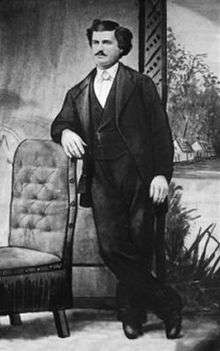
While most witnesses said that the Fanchers were in general a peaceful party whose members behaved well along the trail, rumors spread about misdeeds.[8] Brevet Major James Henry Carleton led the first federal investigation of the murders, published in 1859. He recorded Hamblin's account that the train was alleged to have poisoned a spring near Corn Creek; this resulted in the deaths of 18 head of cattle and two or three people who ate the contaminated meat. Carleton interviewed the father of a child who allegedly died from this poisoned spring, and accepted the sincerity of the grieving father. But, he also included a statement from an investigator who did not believe the Fancher party was capable of poisoning the spring, given its size. Carleton invited readers to consider a potential explanation for the rumors of misdeeds, noting the general atmosphere of distrust among Mormons for strangers at the time, and that some locals appeared jealous of the Fancher party's wealth.[9]
Conspiracy and siege
The Baker–Fancher party left Corn Creek and continued the 125 miles (201 km) to Mountain Meadows, passing Parowan and Cedar City, southern Utah communities led respectively by Stake Presidents William H. Dame and Isaac C. Haight. Haight and Dame were, in addition, the senior regional military leaders of the Mormon militia. As the Baker–Fancher party approached, several meetings were held in Cedar City and nearby Parowan by the local Latter Day Saint (LDS) leaders pondering how to implement Young's declaration of martial law.[10] In the afternoon of Sunday, September 6, Haight held his weekly Stake High Council meeting after church services, and brought up the issue of what to do with the emigrants.[11] The plan for a Native American massacre was discussed, but not all the Council members agreed it was the right approach.[11] The Council resolved to take no action until Haight sent a rider, James Haslam, out the next day to carry an express to Salt Lake City (a six-day round trip on horseback) for Brigham Young's advice, as Utah did not yet have a telegraph system.[11] Following the Council, Isaac C. Haight decided to send a messenger south to John D. Lee.[11] What Haight told Lee remains a mystery, but considering the timing it may have had something to do with Council's decision to wait for advice from Brigham Young.[12]
The somewhat dispirited Baker–Fancher party found water and fresh grazing for its livestock after reaching grassy, mountain-ringed Mountain Meadows, a widely known stopover on the old Spanish Trail, in early September. They anticipated several days of rest and recuperation there before the next 40 miles (64 km) would take them out of Utah. But, on September 7, the party was attacked by Mormon militiamen dressed as Native Americans and some Native American Paiutes.[13] The Baker–Fancher party defended itself by encircling and lowering their wagons, wheels chained together, along with digging shallow trenches and throwing dirt both below and into the wagons, which made a strong barrier. Seven emigrants were killed during the opening attack and were buried somewhere within the wagon encirclement. Sixteen more were wounded.[14][15] The attack continued for five days, during which the besieged families had little or no access to fresh water or game food and their ammunition was depleted.[16] Meanwhile, organization among the local Mormon leadership reportedly broke down.[17] Eventually fear spread among the militia's leaders that some emigrants had caught sight of white men, and had probably discovered who their attackers really were. This resulted in an order to kill all the emigrants,[18] with the exception of small children.[19]
Killings and aftermath of the massacre
| Four of the nine Nauvoo Legion militiamen of the Tenth Regiment "Iron Brigade" who were indicted in 1874 for murder or conspiracy (Not shown: William H. Dame • William C. Stewart • Ellott Willden • Samuel Jukes • George Adair, Jr.) | |||
|---|---|---|---|
 |
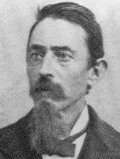 |
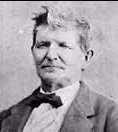 |
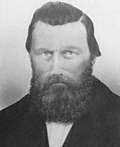 |
| Isaac C. Haight—Battalion Commander—died 1886 Arizona | Maj. John H. Higbee, said to have shouted the command to begin the killings. He claimed that he reluctantly participated in the massacre and only to bury the dead who he thought were victims of an Indian attack. | Maj. John D. Lee, constable, judge, Indian Agent. The only convicted participant, Lee conspired in advance with his immediate commander, Isaac C. Haight. He led the initial assault, and falsely offered emigrants safe passage prior to their mile-long march to the field of the Massacre. | Philip Klingensmith, a Bishop in the church and a private in the militia. He participated in the killings. After leaving the LDS Church he later turned state's evidence against his fellow conspirators. |
On Friday, September 11, 1857, two militiamen approached the Baker–Fancher party wagons with a white flag and were soon followed by Indian Agent and militia officer John D. Lee. Lee told the battle-weary emigrants that he had negotiated a truce with the Paiutes, whereby they could be escorted safely the 36 miles (58 km) back to Cedar City under Mormon protection in exchange for turning all of their livestock and supplies over to the Native Americans.[21] Accepting this, the emigrants were led out of their fortification. The adult men were separated from the women and children. The men were paired with a militia escort. When a signal was given, the militiamen turned and shot the male members of the Baker–Fancher party standing by their side. The women and children were then ambushed and killed by more militia that were hiding in nearby bushes and ravines. Members of the militia were sworn to secrecy. A plan was set to blame the massacre on the Native Americans. The militia did not kill some small children who were deemed too young to relate the story. These children were taken in by local Mormon families. Seventeen of the children were later reclaimed by the U.S. Army and returned to relatives in Arkansas.[22]
Leonard J. Arrington, founder of the Mormon History Association, reports that Brigham Young received the rider, James Haslam, at his office on the same day. When he learned what was contemplated by the militia leaders in Parowan and Cedar City, he sent back a letter stating the Baker–Fancher party were not to be meddled with, and should be allowed to go in peace (although he acknowledged the Native Americans would likely "do as they pleased").[15][23] Young's letter arrived two days too late, on September 13, 1857.
Some of the property of the dead was reportedly taken by the Native Americans involved, while large amounts of their valuables and cattle were taken by the Mormons in Southern Utah, including John D. Lee. Some of the cattle were taken to Salt Lake City and sold or traded. The remaining personal property of the Baker–Fancher party was taken to the tithing house at Cedar City and auctioned off to local Mormons.[24]
Investigations and prosecutions
An early investigation was conducted by Brigham Young,[15] who interviewed John D. Lee on September 29, 1857. In 1858, Young sent a report to the Commissioner of Indian Affairs stating that the massacre was the work of Native Americans. The Utah War delayed any investigation by the U.S. federal government until 1859, when Jacob Forney,[25] and U.S. Army Brevet Major James Henry Carleton conducted investigations. In Carleton's investigation, at Mountain Meadows he found women's hair tangled in sage brush and the bones of children still in their mothers' arms.[26] Carleton later said it was "a sight which can never be forgotten." After gathering up the skulls and bones of those who had died, Carleton's troops buried them and erected a cairn and cross.[26]
Carleton interviewed a few local Mormon settlers and Paiute Native American chiefs, and concluded that there was Mormon involvement in the massacre. He issued a report in May 1859, addressed to the U.S. Assistant Adjutant-General, setting forth his findings. Jacob Forney, Superintendent of Indian Affairs for Utah, also conducted an investigation that included visiting the region in the summer of 1859 and retrieved many of the surviving children of massacre victims who had been housed with Mormon families, and gathered them in preparation of transporting them to their relatives in Arkansas. Forney concluded that the Paiutes did not act alone and the massacre would not have occurred without the white settlers,[27] while Carleton's report to the U.S. Congress called the mass killings a "heinous crime",[9] blaming both local and senior church leaders for the massacre.
A federal judge brought into the territory after the Utah War, Judge John Cradlebaugh, in March 1859 convened a grand jury in Provo, concerning the massacre, but the jury declined any indictments.[28] Nevertheless, Cradlebaugh conducted a tour of the Mountain Meadows area with a military escort.[29] Cradlebaugh attempted to arrest John D. Lee, Isaac Haight, and John Higbee, but these men fled before they could be found.[30] Cradlebaugh publicly charged Brigham Young as an instigator to the massacre and therefore an "accessory before the fact."[29] Possibly as a protective measure against the mistrusted federal court system, Mormon territorial probate court judge Elias Smith arrested Young under a territorial warrant, perhaps hoping to divert any trial of Young into a friendly Mormon territorial court.[31] When no federal charges ensued, Young was apparently released.[29]
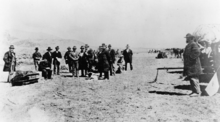
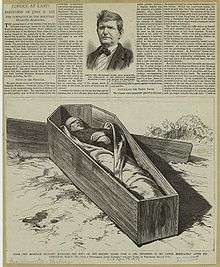
Further investigations, cut short by the American Civil War in 1861,[32] again proceeded in 1871 when prosecutors obtained the affidavit of militia member Philip Klingensmith. Klingensmith had been a bishop and blacksmith from Cedar City; by the 1870s, however, he had left the church and moved to Nevada.[33]
Lee was arrested on November 7, 1874.[34] Dame, Philip Klingensmith and two others (Ellott Willden and George Adair, Jr.) were indicted and arrested while warrants were obtained to pursue the arrests of four others (Haight, Higbee, William C. Stewart and Samuel Jukes) who had gone into hiding. Klingensmith escaped prosecution by agreeing to testify.[35]
Brigham Young removed some participants including Haight and Lee from the LDS Church in 1870. The U.S. posted bounties of $500 ($10109[36] in present-day funds) each for the capture of Haight, Higbee and Stewart, while prosecutors chose not to pursue their cases against Dame, Willden and Adair.
Lee's first trial began on July 23, 1875, in Beaver, before a jury of eight Mormons and four non-Mormons.[37] One of Lee's defense attorneys was former territorial supreme court justice Enos D. Hoge.[38] This trial led to a hung jury on August 5, 1875. Lee's second trial began September 13, 1876, before an all-Mormon jury. The prosecution called Daniel Wells, Laban Morrill, Joel White, Samuel Knight, Samuel McMurdy, Nephi Johnson, and Jacob Hamblin.[39] Lee also stipulated, against advice of counsel, that the prosecution be allowed to re-use the depositions of Young and Smith from the previous trial.[40] Lee called no witnesses in his defense.[41] This time, Lee was convicted.
At Lee's sentencing, as required by Utah Territory statute, he was allowed to choose the method of his own execution - being hanged, shot, or beheaded and Lee chose to be shot.[42] Just before being executed by firing squad at Mountain Meadows on March 23, 1877, Lee professed that he was a scapegoat for others involved.[43] Brigham Young stated that Lee's fate was just, but not a sufficient blood atonement, given the enormity of the crime.[44]
Criticism and analysis of the massacre
Media coverage about the event
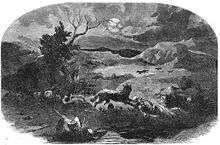
The first published report on the incident was made in 1859 by Carleton, who had been tasked by the U.S. Army to investigate the incident and bury the still exposed corpses at Mountain Meadows.[9] Although the massacre was covered to some extent in the media during the 1850s,[45] the first period of intense nationwide publicity about the massacre began around 1872, after investigators obtained Klingensmith's confession. In 1867 C.V. Waite published "An Authentic History Of Brigham Young" which described the events. In 1872, Mark Twain commented on the massacre through the lens of contemporary American public opinion in an appendix to his semi-autobiographical travel book Roughing It. In 1873, the massacre was a prominent feature of a history by T. B. H. Stenhouse, The Rocky Mountain Saints.[46] National newspapers covered the Lee trials closely from 1874 to 1876, and his execution in 1877 was widely covered.
The massacre has been treated extensively by several historical works, beginning with Lee's own Confession in 1877, expressing his opinion that George A. Smith was sent to southern Utah by Brigham Young to direct the massacre.[47]
In 1910, the massacre was the subject of a short book by Josiah F. Gibbs, who also attributed responsibility for the massacre to Young and Smith.[48] The first detailed and comprehensive work using modern historical methods was The Mountain Meadows Massacre in 1950 by Juanita Brooks, a Mormon scholar who lived near the area in southern Utah. Brooks found no evidence of direct involvement by Brigham Young, but charged him with obstructing the investigation and provoking the attack through his rhetoric.
Initially, the LDS Church denied any involvement by Mormons, and was relatively silent on the issue. In 1872, it excommunicated some of the participants for their role in the massacre.[49] Since then, the LDS Church has condemned the massacre and acknowledged involvement by local Mormon leaders. In September 2007, the LDS Church published an article in its publications marking 150 years since the tragedy occurred.[50][51]
Historical theories explaining the massacre
Historians have ascribed the massacre to a number of factors, including strident Mormon teachings in the years prior to the massacre, war hysteria, and alleged involvement of Brigham Young.
Strident Mormon teachings
For the decade prior to the Baker–Fancher party's arrival there, Utah Territory existed as a theodemocracy led by Brigham Young. During the mid-1850s, Young instituted a Mormon Reformation, intending to "lay the axe at the root of the tree of sin and iniquity". In January 1856, Young said "the government of God, as administered here" may to some seem "despotic" because "...judgment is dealt out against the transgression of the law of God."[52]
In addition, during the prior decades, the religion had undergone a period of intense persecution in the American Midwest, and faithful Mormons moved west to escape persecution in midwestern towns. In particular, they were officially expelled from the state of Missouri during the 1838 Mormon War, during which prominent Mormon apostle David W. Patten was killed in battle. After Mormons moved to Nauvoo, Illinois, the religion's founder Joseph Smith and his brother Hyrum Smith were killed in 1844. Just months before the Mountain Meadows massacre, Mormons received word that yet another apostle had been killed: in April 1857, apostle Parley P. Pratt was shot in Arkansas by Hector McLean, the estranged husband of Eleanor McLean Pratt, one of Pratt's plural wives.[53][54] Parley Pratt and Eleanor entered a Celestial marriage (under the theocratic law of the Utah Territory), but Hector had refused Eleanor a divorce. "When she left San Francisco she left Hector, and later she was to state in a court of law that she had left him as a wife the night he drove her from their home. Whatever the legal situation, she thought of herself as an unmarried woman."[55]
Mormon leaders immediately proclaimed Pratt as another martyr,[56][57] with Brigham Young stating, "Nothing has happened so hard to reconcile my mind to since the death of Joseph" and many Mormons held the people of Arkansas responsible.[58] "It was in accordance with Mormon policy to hold every Arkansan accountable for Pratt's death, just as every Missourian was hated because of the expulsion of the church from that state."[59]
Mormon leaders were teaching that the Second Coming of Jesus was imminent - "...there are those now living upon the earth who will live to see the consummation" and "...we now bear witness that his coming is near at hand".[60] Based on a somewhat ambiguous statement by Joseph Smith, some Mormons believed that Jesus would return in 1891[61] and that God would soon exact punishment against the United States for persecuting Mormons and martyring Joseph Smith, Hyrum Smith, Patten and Pratt.[62] In their Endowment ceremony, faithful early Latter-day Saints took an oath to pray that God would take vengeance against the murderers.[63] As a result of this oath, several Mormon apostles and other leaders considered it their religious duty to kill the prophets' murderers if they ever came across them.[64]
The sermons, blessings, and private counsel by Mormon leaders just before the Mountain Meadows massacre can be understood as encouraging private individuals to execute God's judgment against the wicked.[65][66][67][68][69]
In Cedar City, the teachings of church leaders were particularly strident. Mormons in Cedar City were taught that members should ignore dead bodies and go about their business.[70] Col. William H. Dame, the ranking officer in southern Utah who ordered the Mountain Meadows massacre, received a patriarchal blessing in 1854 that he would "be called to act at the head of a portion of thy Brethren and of the Lamanites (Native Americans) in the redemption of Zion and the avenging of the blood of the prophets upon them that dwell on the earth".[71] In June 1857, Philip Klingensmith, another participant, was similarly blessed that he would participate in "avenging the blood of Brother Joseph".[72][73]
Thus, historians argue that southern Utah Mormons would have been particularly affected by an unsubstantiated[74] rumor that the Baker–Fancher wagon train had been joined by a group of eleven miners and plainsmen who called themselves "Missouri Wildcats", some of whom reportedly taunted, vandalized and "caused trouble" for Mormons and Native Americans along the route (by some accounts claiming that they had the gun that "shot the guts out of Old Joe Smith"[75]) They were also affected by the report to Brigham Young that the Baker–Fancher party was from Arkansas where Pratt was murdered.[76] It was rumored that Pratt's wife recognized some of the Mountain Meadows party as being in the gang that shot and stabbed Pratt.[77]
War hysteria
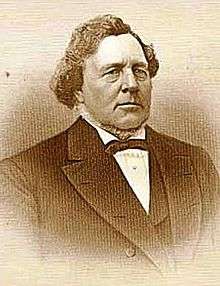
The Mountain Meadows massacre was caused in part by events relating to the Utah War, an 1857 deployment toward the Utah Territory of the United States Army, whose arrival was peaceful. In the summer of 1857, however, the Mormons expected an all-out invasion of apocalyptic significance. From July to September 1857, Mormon leaders and their followers prepared for a siege that could have ended up similar to the seven-year Bleeding Kansas problem occurring at the time. Mormons were required to stockpile grain, and were enjoined against selling grain to emigrants for use as cattle feed. As far-off Mormon colonies retreated, Parowan and Cedar City became isolated and vulnerable outposts. Brigham Young sought to enlist the help of Native American tribes in fighting the "Americans", encouraging them to steal cattle from emigrant trains, and to join Mormons in fighting the approaching army.[78]
Scholars have asserted that George A. Smith's tour of southern Utah influenced the decision to attack and destroy the Fancher–Baker emigrant train near Mountain Meadows, Utah. He met with many of the eventual participants in the massacre, including W. H. Dame, Isaac Haight, John D. Lee and Chief Jackson, leader of a band of Paiutes.[79] He noted that the militia was organized and ready to fight, and that some of them were eager to "fight and take vengeance for the cruelties that had been inflicted upon us in the States."[80] Among Smith's party were a number of Paiute Native American chiefs from the Mountain Meadows area. When Smith returned to Salt Lake, Brigham Young met with these leaders on September 1, 1857, and encouraged them to fight against the Americans in the anticipated clash with the U.S. Army. They were also offered all of the livestock then on the road to California, which included that belonging to the Baker–Fancher party. The Native American chiefs were reluctant, and at least one objected they had previously been told not to steal, and declined the offer.[81]
Brigham Young
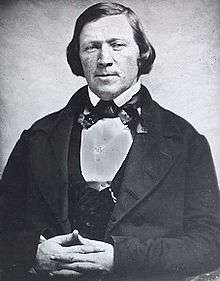
There is a consensus among historians that Brigham Young played a role in provoking the massacre, at least unwittingly, and in concealing its evidence after the fact. However, they debate whether Young knew about the planned massacre ahead of time and whether he initially condoned it before later taking a strong public stand against it. Young's use of inflammatory and violent language[82] in response to the Federal expedition added to the tense atmosphere at the time of the attack. Following the massacre, Young stated in public forums that God had taken vengeance on the Baker–Fancher party.[83] It is unclear whether Young held this view because he believed that this specific group posed an actual threat to colonists or because he believed that the group was directly responsible for past crimes against Mormons. However, in Young's only known correspondence prior to the massacre, he told the Church leaders in Cedar City:
In regard to emigration trains passing through our settlements, we must not interfere with them until they are first notified to keep away. You must not meddle with them. The Indians we expect will do as they please but you should try and preserve good feelings with them. There are no other trains going south that I know of[.] [I]f those who are there will leave let them go in peace.[84]
According to historian MacKinnon, "After the [Utah] war, U.S. President James Buchanan implied that face-to-face communications with Brigham Young might have averted the conflict, and Young argued that a north-south telegraph line in Utah could have prevented the Mountain Meadows massacre."[85] MacKinnon suggests that hostilities could have been avoided if Young had traveled east to Washington D.C. to resolve governmental problems instead of taking a five-week trip north on the eve of the Utah War for church related reasons.[86]
A modern forensic assessment of a key affidavit, purportedly given by William Edwards in 1924, has complicated the debate on complicity of senior Mormon leadership in the Mountain Meadows massacre.[87] Analysis indicates that Edwards's signature may have been traced and that the typeset belonged to a typewriter manufactured in the 1950s. The Utah State Historical Society, which maintains the document in its archives, acknowledges a possible connection to Mark Hofmann, a convicted forger and extortionist, via go-between Lyn Jacobs who provided the society with the document.[88][89]
Remembrances
The first monument for the victims was built two years after the massacre, by Major Carleton and the U.S. Army. This monument was a simple cairn built over the gravesite of 34 victims, and was topped by a large cedar cross.[90] The monument was found destroyed and the structure was replaced by the U.S. Army in 1864.[91] By some reports, the monument was destroyed in 1861, when Young brought an entourage to Mountain Meadows. Wilford Woodruff, who later became President of the Church, claimed that upon reading the inscription on the cross, which read, "Vengeance is mine, thus saith the Lord. I shall repay", Young responded, "it should be vengeance is mine and I have taken a little."[92][93] In 1932 citizens of the surrounding area constructed a memorial wall around the remnants of the monument.[94]
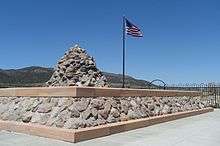
Starting in 1988, the Mountain Meadows Association, composed of descendants of both the Baker–Fancher party victims and the Mormon participants, designed a new monument in the meadows; this monument was completed in 1990 and is maintained by the Utah State Division of Parks and Recreation.[95] In 1999 The Church of Jesus Christ of Latter-day Saints replaced the U.S. Army's cairn and the 1932 memorial wall with a second monument, which it now maintains.[96][97][98] In August 1999, when the LDS Church's construction of the 1999 monument had started, the remains of at least 28 massacre victims were dug up by a backhoe. The forensic evidence showed that the remains of the males had been shot by firearms at close range and that the remains of the women and children showed evidence of blunt force trauma.[26][99]
In 1955, to memorialize the victims of the massacre, a monument was installed in the town square of Harrison, Arkansas. On one side of this monument is a map and short summary of the massacre, while the opposite side contains a list of the victims. In 2005 a replica of the U.S. Army's original 1859 cairn was built in Carrollton, Arkansas; it is maintained by the Mountain Meadows Monument Foundation.[100]
In 2007, the 150th anniversary of the massacre was remembered by a ceremony held in the meadows. Approximately 400 people, including many descendants of those slain at Mountain Meadows and Elder Henry B. Eyring of the LDS Church's Quorum of the Twelve Apostles attended this ceremony.[101][102]
In 2011, the site was designated as a National Historic Landmark after joint efforts by descendants of those killed and the LDS Church.[103]
In 2014, California archaeologist Everett Bassett discovered that the two mass graves of the massacre victims are not located at the site of the monument erected in 1990 by the Mountain Meadows Association but instead on private land nearby. The Mountain Meadows Massacre Foundation is trying to come to an agreement with the land owner for conservation of the sites and wants to give them national monument status.[104]
Media detailing the massacre
- Massacre at Mountain Meadows, by Ronald W. Walker, Richard E. Turley, Glen M. Leonard (2008)
- House of Mourning: A Biocultural History of the Mountain Meadows Massacre, by Shannon A. Novak (2008)
- September Dawn a film by Christopher Cain (2007)
- Burying The Past: Legacy of The Mountain Meadows Massacre", a documentary film by Brian Patrick (2004)
- American Massacre: The Tragedy At Mountain Meadows, September 1857, by Sally Denton (2003)
- Blood of the Prophets: Brigham Young and the Massacre at Mountain Meadows, by Will Bagley (2002)
- The Mountain Meadows Massacre, by Juanita Brooks (1950)
- Red Water, novel by Judith Freeman (2002)
- Godless Netflix miniseries, Episode 2, (2017)
See also
- List of National Historic Landmarks in Utah
- National Register of Historic Places listings in Washington County, Utah
- Haun's Mill massacre, an attack on Mormons
- Missouri Executive Order 44
- Salt Creek Canyon massacre
References
- King, Gilbert (February 29, 2012). "The Aftermath of Mountain Meadows". Smithsonian.com. US Government. Retrieved February 3, 2019.
- Bagley (2002), pp. 55–68; Finck (2018).
- Bancroft (1889) p. 545; Linn (1902) Chap. XVI, 4th full paragraph.
- Bancroft (1889) p. 544; Gibbs (1910) p. 12.
- Shirts, (1994) Paragraph 2
- Shirts, Morris A. (1994). "Mountain Meadows Massacre". In Powell, Allan Kent (ed.). Utah History Encyclopedia. Salt Lake City, Utah: University of Utah Press. ISBN 0874804256. OCLC 30473917. Archived from the original on August 9, 2013. Retrieved December 3, 2019.
- Little, James A. (1881). "Jacob Hamblin: A Narrative of His Personal Experience Fifth Book of the Faith-Promoting Series (Chapter VI)". Gutenberg.com. Juvenile Instructor Office. Retrieved December 3, 2019.
When President Smith returned to Salt Lake City, Brother Thales Haskell and I accompanied him. On our way we camped over night on Corn Creek, twelve miles south of Fillmore, with a party of emigrants from Arkansas, traveling on what was then known as the southern route to California. They inquired of me about the road, and wrote the information down that I gave them. They expressed a wish to lay by at some suitable place to recruit their teams before crossing the desert. I recommended to them, for this purpose, the south end of the Mountain Meadows, three miles from where my family resided. ... Brother Haskell and I remained in Salt Lake City one week, and then started for our homes in Southern Utah. On the way, we heard that the Arkansas company of emigrants had been destroyed at the Mountain Meadows,
- Young, Brigham (April 30, 1877). "Interview with Brigham Young". Deseret News (published May 23, 1877).
If you were to inquire of the people who lived hereabouts, and lived in the country at that time, you would find, ... that some of this Arkansas company ...boasted of having to helped to kill Hyrum and Joseph Smith and the Mormons in Missouri, and that they never meant to leave the Territory until similar scenes were enacted here.
- Carleton, James Henry (1859). Special Report of the Mountain Meadow Massacre. Washington: Government Printing Office (published 1902).
- Shirts (1994), Paragraph 6
- Morrill, Laban (September 1876). "Laban Morrill Testimony—Witness for the Prosecution at Second Trial of John D. Lee September 14 to 20, 1876 (Mountain Meadows Massacre Trials (John D. Lee Trials) 1875–1876)". The Mountain Meadows Association. Retrieved February 11, 2019..
- Walker, Ronald W., Richard E. Turley, JR., Glen M. Leonard (2008). Massacre at Mountain Meadows. Oxford University Press. p. 157. ISBN 978-0-19-516034-5.
- Shirts, (1994) Paragraph 8
- Penrose, Charles W.; Haslam, James Holt (1885). Supplement to the lecture on the Mountain Meadows massacre. Important additional testimony recently received. Salt Lake City: Printed at Juvenile Instructor Office.
- Brigham Young: American Moses, Leonard J. Arrington, University of Illinois Press, (1986), p. 257
- Shirts, 1994 Paragraph 8
- Shirts, (1994) Paragraph 6
- Walker, Ronald W. (2003). ""Save the emigrants", Joseph Clewes on the Mountain Meadows massacre (Joseph Clewes - eyewitness - Statement)" (PDF). BYU Studies. 42 (1): 139–152.
...it was made known by Higbee that the emigrants were to be wiped out.
- Walker, Ronald W.; Turley, Richard E.; Leonard, Glen M. (2008). Massacre at Mountain Meadows. New York: Oxford University Press. pp. 174, 178–180. ISBN 978-0-19-516034-5.
- "Mountain Meadows Massacre Site in Utah by Phil Konstantin". americanindian.net.
- Shirts, (1994) Paragraph 9.
- Brooks, 1950, pp. 101–105.
- Brigham Young to Isaac C. Haight, September. 10, 1857, Letterpress Copybook 3:827–28, Brigham Young Office Files, LDS Church Archives.
- Klingensmith, Philip (September 5, 1872). Written at Lincoln County, Nevada. Toohy, Dennis J. (ed.). "Mountain Meadows Massacre, Affidavit of Philip Klingensmith". Corinne Journal Reporter. Corinne, Utah (published September 24, 1872). 5 (252): 1. Archived from the original on May 17, 2016. Retrieved February 11, 2019.
- Forney 1859, p. 1.
- Fisher, Alyssa (September 16, 2003). "The Mountain Meadows Massacre "A Sight Which Can Never Be Forgotten"". Archaeology.com. Archaeological Institute of America. Retrieved February 4, 2019.
- Forney 1859, p. 1
- Cradlebaugh 1859, p. 3; Carrington 1859, p. 2.
- Bagley 2002, p. 225
- Bagley 2002, p. 226
- Bagley 2002, p. 234
- Brooks 1950, p. 133
- Briggs 2006, p. 315
- "John D. Lee Arrested", Deseret News, November 18, 1874, p. 16.
- "Tragedy at Mountain Meadows Massacre: Toward a Consensus Account and Time Line". Archived from the original on July 26, 2011.
- Federal Reserve Bank of Minneapolis. "Consumer Price Index (estimate) 1800–". Retrieved January 1, 2020.
- "The Lee Trial", Deseret News, July 28, 1875, p. 5.
- Orson Ferguson Whitney, Popular History of Utah (1916), p. 305.
- Lee 1877, pp. 317–78.
- Lee 1877, pp. 302–03
- Lee 1877, p. 378.
- "Territorial Dispatches: the Sentence of Lee", Deseret News, October 18, 1876, p. 4.
- Lee 1877, pp. 225–226
- Young, Brigham (May 30, 1877). "Interview with Brigham Young". UDN/Utah Digital Newspapers. (Utah Digital Newspapers, J. Willard Marriott Library/University of Utah)The Deseret News. Retrieved February 4, 2019.
[After being asked by the interviewer if he believed in blood atonement, Young replied] "I do, and I believe that Lee has not half atoned for his great crime"
- Lyman, Edward Leo (2004). The Overland Journey from Utah to California: Wagon Travel from the City of Saints to the City of Angels (Hardcover ed.). University of Nevada Press. p. 138. ISBN 978-0874175011. Retrieved February 4, 2019.
- Stenhouse 1873.
- Lee, John D. (1877). Bishop, William W. (ed.). Mormonism Unveiled; or the Life and Confessions of the Late Mormon Bishop, John D. Lee. St. Louis, Missouri: Bryan, Brand & Co. ISBN 978-1-4366-1518-1.
- Gibbs 1910.
- Bagley, Will (2002), Blood of the prophets : Brigham Young and the massacre at Mountain Meadows, Norman: University of Oklahoma Press, p. 273, ISBN 978-0-8061-3639-4
- Turley, Richard E., Jr. (September 2007). "The Mountain Meadows Massacre". Ensign (LDS magazine). Archived from the original on July 8, 2008. Retrieved March 26, 2020.
- Michael De Groote, Writing 'Massacre at Mountain Meadows' Archived February 21, 2009, at the Wayback Machine, Mormon Times, Sep. 11, 2008
- Young, Brigham. "THE POWERS OF THE PRIESTHOOD NOT GENERALLY UNDERSTOOD--THE NECESSITY OF LIVING BY REVELATION--THE ABUSE OF BLESSINGS". Book of Abraham Project. Brigham Young University. Retrieved February 4, 2019.
Is the spirit of the government and rule here despotic? In their use of the word, some may deem it so. It lays the ax at the root of the tree of sin and iniquity; judgment is dealt out against the transgression of the law of God. If that is despotism, then the policy of this people may be deemed despotic. But does not the government of God, as administered here, give to every person his rights?
- Eleanor McLean Pratt (May 12, 1857). "To the Honorable Judge of the Court, in the town of Van Buren, State of Arkansas, May 12, 1957 (Mrs. Pratt's Letter to the Judge)". The Latter-Day Saints' Millennial Star, Volume 19. pp. 425–426. Retrieved February 10, 2019.
- "Further Particulars of the Murder - To Brother Orson (A letter from Eleanor McLean Pratt)". The Latter-Day Saints' Millennial Star, Volume 19. May 12, 1857. pp. 426–427. Retrieved February 10, 2019.
- Pratt, Steven (1974). "Eleanor McLean and the Murder of Parley P. Pratt". Brigham Young University Studies. 15 (2): 233. JSTOR 43040559.
"When she left San Francisco she left Hector, and later she was to state in a court of law that she had left him as a wife the night he drove her from their home. Whatever the legal situation, she thought of herself as an unmarried woman.
- "Murder of Parley P. Pratt, One of the Twelve Apostles of The Church of Jesus Christ of Latter-day Saints". The Latter-day Saints' Millennial Star Vol. 19. Retrieved February 11, 2019.
- Pratt 1975, p.16 "I die a firm believer in the Gospel of Jesus Christ as revealed through the Prophet Joseph Smith ... I am dying a martyr to the faith.
- Brooks 1950, pp. 36–37
- Linn (1902) pp. 519-520
- Young, Kimball, Hyde, Pratt 1845, pp. 2 & 5
- Erickson, p. 9
- Grant, Jedediah M. (April 2, 1854). "Fulfilment of Prophecy—Wars and Commotions". In Watt, G.D. (ed.). Journal of Discourses. 2. Liverpool: F.D. & S.W. Richards (published 1855). pp. 148–49.
It is a stern fact that the people of the United States have shed the blood of the Prophets, driven out the Saints of God,...consequently I look for the Lord to use His whip on the refractory son called 'Uncle Sam';...
- Diary of Heber C. Kimball (December 21, 1845); Beadle 1870, pp. 496–97 (describing the oath prior to 1970 as requiring a "private, immediate duty to avenge the death of the Prophet and Martyr, Joseph Smith"); George Q. Cannon (Daily Journal of Abraham H. Cannon, December 6, 1889, p. 205). In 1904, several witnesses said that the oath as it then existed was that participants would never cease to pray that God would avenge the blood of the prophets on this nation", and that they would teach this practice to their posterity "unto the 3rd and 4th generation". Buerger 2002, p. 134 The oath was deleted from the ceremony in the early 20th century.
- Diary of Heber C. Kimball (December 21, 1845) (saying that in the temple he had "covenanted, and will never rest...until those men who killed Joseph & Hyrum have been wiped out of the earth"); George Q. Cannon (Daily Journal of Abraham H. Cannon, December 6, 1889, p. 205) (stating that he understood that his Endowment in Nauvoo included "an oath against the murders of the Prophet Joseph as well as other prophets, and if he had ever met any of those who had taken a hand in that massacre he would undoubtedly have attempted to avenge the blood of the Martyrs").
- Diary of Daniel Davis, July 8, 1849, the LDS archives - as quoted in Quinn (1997) p.247
- (A Mormon who listened to a sermon by Young in 1849 recorded that Young said "if any one was catched stealing to shoot them dead on the spot and they should not be hurt for it"); Young 1856b, p. 247 (stating that a man would be justified in putting a javelin through his plural wife caught in the act of adultery, but anyone intending to "execute judgment...has got to have clean hands and a pure heart...else they had better let the matter alone");
- Young 1857b, p. 219 ("[I]f [your neighbor] needs help, help him; and if he wants salvation and it is necessary to spill his blood on the earth in order that he may be saved, spill it")
- Young 1855, p. 311 ("[I]n regard to those who have persecuted this people and driven them to the mountains, I intend to meet them on their own grounds...I will tell you how it could be done, we could take the same law they have taken, viz., mobocracy, and if any miserable scoundrels come here, cut their throats. (All the people said, Amen).");
- Quinn (1997), p. 260 Quote: "LDS leaders publicly and privately encouraged Mormons to consider it their right to kill antagonistic outsiders, common criminals, LDS apostates, and even faithful Mormons who committed sins "worthy of death".
- See Letter from Mary L. Campbell to Andrew Jenson, January 24, 1892, LDS archives, in Moorman & Sessions, Camp Floyd and the Mormons, p. 142.
- See Patriarchal blessing of William H. Dame, February 20, 1854, in Harold W. Pease, "The Life and Works of William Horne Dame", M.A. thesis, BYU, 1971, pp. 64–66.
- See Patriarchal blessing of Philip Klingensmith, Anna Jean Backus, Mountain Meadows Witness: The Life and Times of Bishop Philip Klingensmith (Spokane: Arthur H. Clark Co., 1995), pp. 118, 124;
- Scott, Malinda Cameron (1877). "Malinda (Cameron) Scott Thurston Deposition". Mountain Meadows Association. Retrieved February 4, 2019.
- It is uncertain whether the Missouri Wildcat group stayed with the slow-moving Baker–Fancher party after leaving Salt Lake City. See Brooks 1991, page xxi; Bagley (2002), p. 280 (referring to the "Missouri Wildcats" story as "Utah mythology".
- Mountain Meadows Massacre in Tietoa Mormonismista Suomeksi. See PBS Episode 4 and UTLM Newsletters #88 and essay at youknow.com Archived October 14, 2007, at the Wayback Machine
- Young (1875)
- Stenhouse 1873, p. 431 (citing "Argus", an anonymous contributor to the Corinne Daily Reporter whom Stenhouse met and vouched for).
- Lyman, Edward Leo (2004). The Overland Journey from Utah to California: Wagon Travel from the City of Saints to the City of Angels (Hardcover ed.). University of Nevada Press. p. 130. ISBN 978-0874175011. Retrieved February 4, 2019.
- Martineau 1857
- Lyman, Edward Leo (2004). The Overland Journey from Utah to California: Wagon Travel from the City of Saints to the City of Angels (Hardcover ed.). University of Nevada Press. p. 133. ISBN 978-0874175011. Retrieved February 4, 2019.
- Dimick B. Huntington. "Huntington Journal". www.mtn-meadows-assoc.com.
- MacKinnon, p. 57
- Bagley 2002, p. 247.
- Brigham Young to Isaac C. Haight, 10 September 1857, Letterpress Copybook 3:827–28, Brigham Young Office Files, LDS Church Archives.
- MacKinnon, endnote 50
- MacKinnon, p. 17
- Mountain Meadows Massacre Artifact Now Believed To Be A Fake Archived August 18, 2005, at the Wayback Machine Jeffreys, Keith B. (2010). Free Inquiry magazine, 22(4).
- Mountain Meadows affidavit Hofmann forgery? Smart, Christopher. (Sept. 10, 2010). Salt Lake Tribune.
- Probable Hofmann Forgery Uncovered The Utah Division of State History. (2010). Press Release.
- Carleton, James H. (1902). Special Report of the Mountain Meadows Massacre. Government Printing Office. p. 15. ISBN 978-0-87062-249-6.
- "Utah Digital Newspapers". newspapers.lib.utah.edu.
- Sally Denton (2003). American Massacre: The Tragedy at Mountain Meadows, September 1857 (New York: Vintage Books, ISBN 0-375-72636-5) p. 210.
- Scott G. Kenney, ed., Wilford Woodruff's Journal, 9 vols. (Salt Lake City: Signature Books, 1984), 5:577.
- Shirts, Morris A. (1994). Powell, Allan Kent (ed.). Mountain Meadows Massacre (Utah History Encyclopedia). Salt Lake City, Utah: University of Utah Press. ISBN 978-0874804256. OCLC 30473917.
The most enduring was a wall which still stands at the siege site. It was erected in 1932 and surrounds the 1859 cairn.
- "Mountain Meadows Association – 1990 MONUMENT". Mountain Meadows Association. Retrieved May 16, 2010.
- Utah History To Go. Pioneers and Cowboys. Morris A. Shirts, Mountain Meadows Massacre. Retrieved March 9, 2009.
- Mountain Meadows Association. 1990 Monument. Retrieved March 9, 2009.
- Mountain Meadows Association. 1999 Monument. Retrieved March 9, 2009.
- Brown-Hovelt, Luscinia; Himelfarb, Elizabeth J. (November 30, 1999). "Mountain Meadows Massacre". Archaeology. Archaeological Institute of America. Retrieved February 4, 2019.
- Flickr. J. Stephen Conn's photostream. Mountain Meadows Massacre Monument (photograph). Retrieved March 9, 2009.
- "Eyring expresses regret for pioneer massacre".
- Ravitz, Jessica, LDS Church Apologizes for Mountain Meadows Massacre, Salt Lake Tribune; September 11, 2007.
- Stack, Peggy Fletcher (June 30, 2011). "Mountain Meadows now a national historic landmark". Salt Lake Tribune. Retrieved July 4, 2011.
- Osinski, Nichole (September 20, 2015). "Archaeologist: Mountain Meadows Massacre graves found". The (St. George, Utah) Spectrum.
Bibliography
- Abanes, Richard (2003), One Nation Under Gods: A History of the Mormon Church, New York: Four Walls Eight Windows, ISBN 1-56858-283-8
- Bagley, Will and David L. Bigler (2008), Innocent Blood: Essential Narratives of the Mountain Meadows Massacre, Norman, Oklahoma: The Arthur H. Clark Company, ISBN 978-0-87062-362-2
- Bagley, Will (2002), Blood of the Prophets: Brigham Young and the Massacre at Mountain Meadows, Norman, Oklahoma: University of Oklahoma Press, ISBN 978-0-8061-3426-0.
- The Works of Hubert Howe Bancroft: History of Utah, 1540–1886 by Hubert Howe Bancroft, Volume 26 (1889)/publisher History Company Internet Archive versions).
- Beadle, John Hanson (1870), "Chapter VI. The Bloody Period.", Life in Utah, Philadelphia: National Publishing, pp. 177–195, ISBN 978-0-8369-5951-2, LCCN 30005377, LCC BX8645 .B4 1870.
- The Mountain Meadows Massacre: An Analytical Narrative Based on Participant Confessions by Robert H. Briggs in Utah Historical Quarterly, Volume 74, Issue 4, 2006, pages 313-333
- Brooks, Juanita (1962) [1st pub. 1950]. The Mountain Meadows Massacre (1st paperback ed.). Norman, Oklahoma: University of Oklahoma Press. ISBN 978-0806123189..
- Brown (October 3, 1857). "Rumored Massacre on the Plains". Los Angeles Star. p. 1.
- Buerger, David John (2002), The Mysteries of Godliness: A History of Mormon Temple Worship (2nd ed.), Salt Lake City: Signature Books, ISBN 978-1-56085-176-9
- Cannon, Frank J.; Knapp, George L. (1913). "Brigham Young and His Mormon Empire". New York: Fleming H. Revell Co. pp. 273–283..
- Carleton, James Henry (1859). Special Report of the Mountain Meadow Massacre. Washington: Government Printing Office (published 1902)..
- Carrington, Albert, ed. (April 6, 1859). "The Court & the Army". Deseret News. p. 2..
- Christian, J. Ward (October 4, 1857). Hamilton, Henry (ed.). "Horrible Massacre of Arkansas and Missouri Emigrants (Letter to G.N. Whitman)". Los Angeles Star. San Bernardino (published October 10, 1857).
- Cradlebaugh, John (March 15, 1859). Anderson, Kirk (ed.). "Charge (Orally delivered by Hon. John Cradlebaugh to the Grand Jury, Provo, Tuesday, March 8, 1859) [content hosted at J. Willard Marriott Library, University of Utah]". Valley Tan. p. 1..
- Cradlebaugh, John (March 29, 1859). Anderson, Kirk (ed.). "Discharge of the Grand Jury [content hosted at J. Willard Marriott Library, University of Utah]". Valley Tan. p. 3..
- Cradlebaugh, John (February 7, 1863). "Utah and the Mormons: a Speech on the Admission of Utah as a State". 37th United States Congress, 3rd Session. pp. 119–125.CS1 maint: location (link).
- Crockett, Robert D. (2003). "A trial lawyer reviews Will Bagleys' Blood of the Prophets" (PDF). FARMS Review. 15 (2): 199–254..
- Cuch, Forrest S. (2000). "The Paiute Tribe of Utah/The Mountain Meadows Massacre". The History Of Utahs American Indians. Salt Lake City: Utah State Division of Indian Affairs : Utah State Division of History : Distributed by Utah State University Press. pp. 131–139. ISBN 978-0-913738-48-1. OCLC 45321868. Retrieved July 8, 2007..
- Denton, Sally (2003). American Massacre: The Tragedy at Mountain Meadows. New York: Alfred A. Knopf. ISBN 978-0-375-41208-0..
- Dunn, Jacob Piatt (1886). Massacres of the Mountains: A History of the Indian Wars of the Far West. New York: Harper & Brothers. ISBN 978-0-8117-2813-3..
- Erickson, Dan (1996). "Joseph Smith's 1891 Millennial Prophecy: The Quest for Apocalyptic Deliverance". Journal of Mormon History. 22 (2): 1–34. JSTOR 23287437..
- Finck, James (2018). "Mountain Meadows Massacre". Encyclopedia of Arkansas History & Culture. Little Rock, Arkansas: Encyclopedia of Arkansas Project.
- Fisher, Alyssa (September 16, 2003). "A Sight Which Can Never Be Forgotten". Archaeology. Archaeological Institute of America..
- Forney, J. (May 5, 1859). "Kirk Anderson Esq". Valley Tan (published May 10, 1859). p. 1.
- Forney, J[acob]. (May 5, 1859). "Visit of the Superintendent of Indian Affairs to Southern Utah". Deseret News (published May 11, 1859). p. 1..
- Gibbs, Josiah F. (1910), The Mountain Meadows Massacre, Salt Lake City: Salt Lake Tribune, ISBN 978-0-548-30943-8, LCCN 37010372, LCC F826 .G532.
- Gordon, Sarah Barringer; Shipps, Jan (Summer 2017). "Fatal Convergence in the Kingdom of God: The Mountain Meadows Massacre in American History" (PDF). Journal of the Early Republic. 37: 1–41. Retrieved February 9, 2019.
- Grant, Jedediah M. (March 12, 1854). Discourse. Deseret News. 4 (published July 27, 1854). pp. 1–2. ISBN 978-0-9653734-4-9. Archived from the original on December 15, 2012. Retrieved April 9, 2020..
- Hamblin, Jacob (September 1876). Linder, Douglas (ed.). "Mountain Meadows Massacre Trials (John D. Lee Trials) 1875–1876, Testimony of Jacob Hamblin". University of Missouri-Kansas City School of Law (published 2006). Retrieved February 10, 2019..
- Huntington, Dimick B. (1857). Journal. LDS Archives, Ms d. 1419. ISBN 978-0-87328-181-2.CS1 maint: location (link).
- Kimball, Heber C. (August 16, 1857). "Limits of Forebearance—Apostates—Economy—Giving Endowments". In Watt, G.D. (ed.). Journal of Discourses. 4. Liverpool: S.W. Richards (published 1857). pp. 374–76..
- Kimball, Heber C. (August 28, 1859). "Greater Responsibilities of Those Who Know the Truth, &c.". In Lyman, Amasa (ed.). Journal of Discourses Delivered by President Brigham Young, His Two Counsellors, the Twelve Apostles, and Others. 7. Liverpool: Amasa Lyman (published 1860). pp. 231–37.
- Klingensmith, Philip (July 23–24, 1875). Written at Beaver City, Utah. "Testimony of Philip J Klingensmith in the First trial of John D. Lee". Braintree, MA: Mountain Meadows Association..
- Lee, John D. (1877). Bishop, William W. (ed.). Mormonism Unveiled; or the Life and Confessions of the Late Mormon Bishop, John D. Lee. St. Louis, Missouri: Bryan, Brand & Co. ISBN 978-1-4366-1518-1.
- Linn, William Alexander (1902). The Story of the Mormons: From the Date of their Origin to the Year 1901. New York: Macmillan. ISBN 978-1-4191-8411-6. (scanned versions).
- MacKinnon, William P. (2007). "Loose in the stacks, a half-century with the Utah War and its legacy" (PDF). Dialogue: A Journal of Mormon Thought. 40 (1): 43–81.
- Martineau, James H. (August 22, 1857), "Correspondence: Trip to the Santa Clara", Deseret News, Parowan, Utah Territory (published September 23, 1857), 9 (5), p. 3.
- Morrill, Laban (September 1876). "Laban Morrill Testimony—Witness for the Prosecution at Second Trial of John D. Lee September 14 to 20, 1876 (Mountain Meadows Massacre Trials (John D. Lee Trials) 1875–1876)". The Mountain Meadows Association. Archived from the original on October 13, 2018. Retrieved February 11, 2019.
- Novak, Shannon; Rodseth, Lars (2006). "Remembering Mountain Meadows: Collective violence and manipulation of social boundaries". Journal of Anthropological Research. The University of Chicago Press. 62 (1): 1–25. doi:10.3998/jar.0521004.0062.101. ISSN 0091-7710. JSTOR 3630719..
- Penrose, Charles W.; Haslam, James Holt (1885). "Supplement to the lecture on the Mountain Meadows massacre. Important additional testimony recently received". Salt Lake City: Printed at Juvenile Instructor Office. p. 40..
- Pratt, Steven (1975). "Eleanor McLean and the Murder of Parley P. Pratt" (PDF). BYU Studies. 15 (2): 1–29..
- Quinn, D. Michael (1997). The Mormon Hierarchy: Extensions of Power. Salt Lake City: Signature Books. ISBN 978-1-56085-060-1..
- Quinn, D. Michael (2001). "LDS 'Headquarters Culture' and the Rest of Mormonism: Past and Present" (PDF). Dialogue: A Journal of Mormon Thought. 34 (3–4): 135–64..
- Malinda (Cameron) Scott Thurston Deposition published by Mountain Meadows Association
- Sessions, Gene (2003). "Shining New Light on the Mountain Meadows Massacre (2003 FairMormon Conference)". FAIR..
- Smith, George A. (July 30, 1875). "Deposition, People v. Lee". Deseret News. Salt Lake City (published August 4, 1875). p. 1..
- Stenhouse, T.B.H. (1873), The Rocky Mountain Saints: a Full and Complete History of the Mormons, from the First Vision of Joseph Smith to the Last Courtship of Brigham Young, New York: D. Appleton, LCCN 16024014, LCC BX8611 .S8 1873, ASIN: B00085RMQM.
- Twain, Mark (1873). Roughing It. Hartford, Conn.: American Publishing. ISBN 978-0-19-515979-0..
- Waite, C.V. (Catharine Van Valkenburg) (1868). The Mormon Prophet and His Harem: Or, an Authentic History of Brigham Young, His Numerous Wives and Children. Chicago: J.S. Goodman & Co. ISBN 978-0-665-37321-3..
- Young, Brigham; Kimball, Heber C.; Hyde, Orson; Pratt, Parley P.; Smith, William; Pratt, Orson; Page, John E.; Taylor, John; et al. (April 6, 1845). "Proclamation of the Twelve Apostles of The Church of Jesus Christ of Latter-day Saints". New York: LDS Church..
- Young, Brigham (July 8, 1855), "The Kingdom of God", in Watt, G.D. (ed.), Journal of Discourses, 2, Liverpool: F.D. & S.W. Richards (published 1855), pp. 309–17.
- Young, Brigham (March 16, 1856), "Instructions to the Bishops—Men Judged According to their Knowledge—Organization of the Spirit and Body—Thought and Labor to be Blended Together", in Watt, G.D. (ed.), Journal of Discourses, 3, Liverpool: Orson Pratt (published 1856), pp. 243–49.
- Young, Brigham (February 8, 1857), "To Know God is Eternal Life—God the Father of Our Spirits and Bodies—Things Created Spiritually First—Atonement by the Shedding of Blood", in Watt, G.D. (ed.), Journal of Discourses, 4, Liverpool: S.W. Richards (published 1857), pp. 215–21.
- Young, Brigham (July 30, 1875). "Deposition, People v. Lee". Deseret News. Salt Lake City (published August 4, 1875). p. 8..
External links
| Wikimedia Commons has media related to Mountain Meadows massacre. |

.png)

